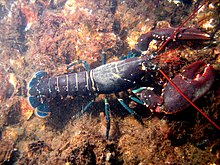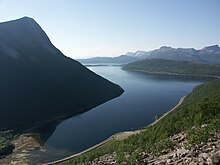Homarus gammarus
| Homarus gammarus | |
|---|---|

| |
| Scientific classification | |
| Domain: | Eukaryota |
| Kingdom: | Animalia |
| Phylum: | Arthropoda |
| Class: | Malacostraca |
| Order: | Decapoda |
| Suborder: | Pleocyemata |
| Family: | Nephropidae |
| Genus: | Homarus |
| Species: | H. gammarus
|
| Binomial name | |
| Homarus gammarus | |
| Synonyms[2] | |
| |
Homarus gammarus, known as the European lobster or common lobster, is a species of
Description

Homarus gammarus is a large crustacean, with a body length up to 60 centimetres (24 in) and weighing up to 5–6 kilograms (11–13 lb), although the lobsters caught in lobster pots are usually 23–38 cm (9–15 in) long and weigh 0.7–2.2 kg (1.5–4.9 lb).[3] Like other crustaceans, lobsters have a hard exoskeleton which they must shed in order to grow, in a process called ecdysis (molting).[4] This may occur several times a year for young lobsters, but decreases to once every 1–2 years for larger animals.[4]
The first pair of
The exoskeleton is generally blue above, with spots that coalesce, and yellow below.[6] The red colour associated with lobsters only appears after cooking.[7] This occurs because, in life, the red pigment astaxanthin is bound to a protein complex, but the complex is broken up by the heat of cooking, releasing the red pigment.[8]
The closest relative of H. gammarus is the American lobster, Homarus americanus. The two species are very similar, and can be crossed artificially, although hybrids are unlikely to occur in the wild since their ranges do not overlap.[9] The two species can be distinguished by a number of characteristics:[4]
- The rostrum of H. americanus bears one or more spines on the underside, which are lacking in H. gammarus.
- The spines on the claws of H. americanus are red or red-tipped, while those of H. gammarus are white or white-tipped.
- The underside of the claw of H. americanus is orange or red, while that of H. gammarus is creamy white or very pale red.
Life cycle
Female H. gammarus reach
The eggs hatch at night, and the
Distribution

Homarus gammarus is found across the north-eastern Atlantic Ocean from northern Norway to the Azores and Morocco, not including the Baltic Sea. It is also present in most of the Mediterranean Sea, only missing from the section east of Crete, and along only the south-west coast of the Black Sea.[2] The northernmost populations are found in the Norwegian fjords Tysfjorden and Nordfolda, inside the Arctic Circle.[11]
The species can be divided into four
Attempts have been made to introduce H. gammarus to New Zealand, alongside other European species such as the edible crab,
Ecology
Adult H. gammarus live on the continental shelf at depths of 0–150 metres (0–492 ft), although not normally deeper than 50 m (160 ft).[2] They prefer hard substrates, such as rocks or hard mud, and live in holes or crevices, emerging at night to feed.[2]
The diet of H. gammarus mostly consists of other benthic invertebrates. These include crabs, molluscs, sea urchins, starfish and polychaete worms.[10]
The three clawed lobster species Homarus gammarus,
Homarus gammarus is susceptible to the disease
Human consumption

Homarus gammarus is traditionally "highly esteemed" as a foodstuff and was mentioned in "
Lobsters are mostly fished using lobster pots, although lines baited with octopus or cuttlefish sometimes succeed in tempting them out, to allow them to be caught in a net or by hand.[2] In 2008, 4,386 t of H. gammarus were caught across Europe and North Africa, of which 3,462 t (79%) was caught in the British Isles (including the Channel Islands).[19] The minimum landing size for H. gammarus is a carapace length of 87 mm (3.4 in).[20] To protect known breeding females, lobsters caught carrying eggs are to be notched on a uropod, the inner tail flap of female lobsters of reproductive size (usually above the minimum landing size 87mm carapace length). Following this, it is illegal for the female to be kept or sold, and is commonly referred to as a "v-notch". This notch remains for three molts of the lobster exoskeleton, providing harvest protection and continued breeding availability for 3–5 years.[21]
Aquaculture systems for H. gammarus are under development, and production rates are still very low.[12]
Taxonomic history
Homarus gammarus was first given a binomial name by Carl Linnaeus in the tenth edition of his Systema Naturae, published in 1758. That name was Cancer gammarus, since Linnaeus' concept of the genus Cancer at that time included all large crustaceans.[22]
H. gammarus is the type species of the genus Homarus Weber, 1795, as determined by Direction 51 of the International Commission on Zoological Nomenclature.[23] Prior to that direction, confusion arose because the species had been referred to by several different names, including Astacus marinus Fabricius, 1775 and Homarus vulgaris H. Milne-Edwards, 1837, and also because Friedrich Weber's description of the genus had been overlooked until rediscovered by Mary J. Rathbun, rendering any prior assignments of type species (for Homarus H. Milne-Edwards, 1837) invalid for Homarus Weber, 1795.[24]
The
The common name for H. gammarus preferred by the Food and Agriculture Organization is "European lobster",[2] but the species is also widely known as the "common lobster".[6][25]
References
- . Retrieved 19 November 2021.
- ^ ISBN 92-5-103027-8. Archived from the originalon September 10, 2010. Retrieved September 30, 2010.
- ^ "European lobster: notes on the sizes of Homarus gammarus". British Marine Life Study Society. Retrieved October 14, 2010.
- ^ a b c d e f g h i j k l Beard, T. W.; McGregor, D. (2004). "Store and care of live lobsters" (PDF). Laboratory Leaflet Number 66 (Revised). Lowestoft: Centre for Environment, Fisheries and Aquaculture Science. Retrieved September 30, 2010.
- ^ "Orange lobster with two sharp claws is one in a million (or more)". National Marine Aquarium. Retrieved September 29, 2010.
- ^ ISBN 978-0-19-854055-7.
- ISBN 978-1-58008-450-5.
- ISBN 978-1-4437-6734-7.
- ^ Hauge, Marie (May 2010). "Unique lobster hybrid". Norwegian Institute of Marine Research. Retrieved September 30, 2010.
- ^ a b c "Biology of the European lobster, Homarus gammarus". UK National Lobster Hatchery. Archived from the original on November 14, 2012. Retrieved November 14, 2012.
- ^ S2CID 84360568.
- ^ a b c P. A. Prodöhl; K. E. Jørstad; A. Triantafyllidis; V. Katsares; C. Triantaphyllidis. "European lobster Homarus gammarus" (PDF). Genetic Impact of Aquaculture Activities on Native Populations. Norwegian Institute of Marine Research. pp. 91–98. Archived from the original (PDF) on July 24, 2011. Retrieved September 29, 2010.
- S2CID 83871032.
- ISBN 978-3-540-30022-9.
- S2CID 84418494.
- Bishop Percy's FolioManuscript: loose and humorous songs ed. Frederick J. Furnivall. London, 1868
- ^ ISBN 978-1-58008-451-2.
- PMID 19334784.
- ^ "Fishery Statistical Collections. Global Production". Fisheries Global Information System. Food and Agriculture Organization. Retrieved September 30, 2010.
- ^ "Minimum fish sizes" (PDF). Department for Environment, Food and Rural Affairs. Archived from the original (PDF) on November 6, 2009. Retrieved September 30, 2010.
- ^ "The Lobsters and Crawfish (Prohibition of Fishing and Landing) Order 2000". Crown Copyright 2000. Retrieved 28 December 2017.
- ^ Boxshall, Geoff (2007). "Crustacean classification: on-going controversies and unresolved problems" (PDF). In Z.-Q. Zhang; W. A. Shear (eds.). Linnaeus Tercentenary: Progress in Invertebrate Taxonomy. pp. 313–325.
- ^ "Official Lists and Indexes of Names in Zoology" (PDF). International Commission on Zoological Nomenclature. March 31, 2010. Archived from the original (PDF) on June 30, 2009. Retrieved October 14, 2010.
- .
- ^ "Common lobster (Homarus gammarus)". ARKive. Archived from the original on 2011-01-11. Retrieved September 30, 2010.
Further reading
- Monaco, Emily (July 14, 2023). "France's illustrious blue 'Breton lobster'". BBC. Retrieved September 14, 2023.
External links
 Media related to Homarus gammarus at Wikimedia Commons
Media related to Homarus gammarus at Wikimedia Commons- Photos of Homarus gammarus on Sealife Collection

